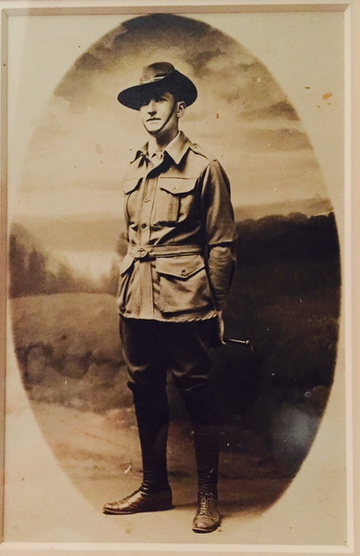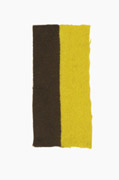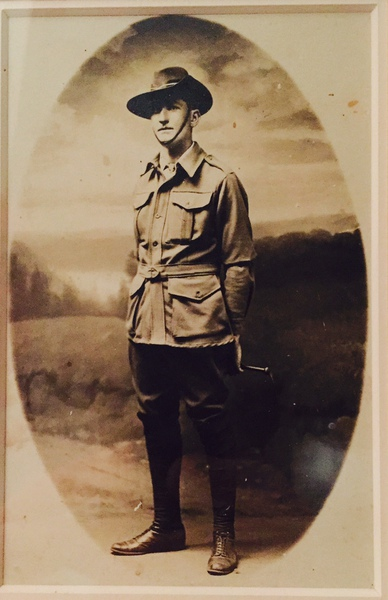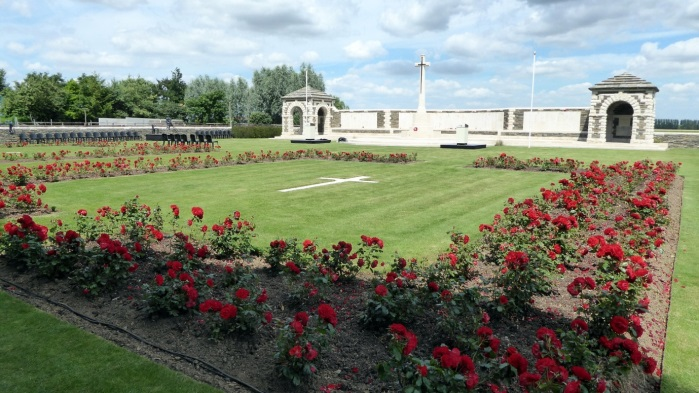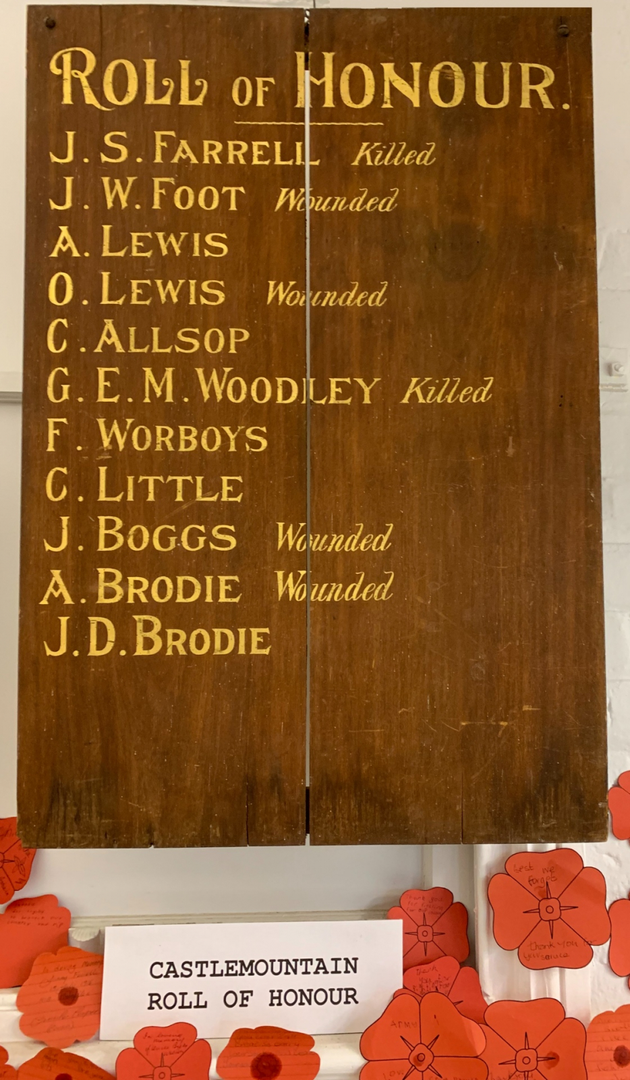James Stephen FARRELL
Eyes hair auburn red hair, Hair eyes grey, Complexion fair
2130, Private James Stephen Farrell, 31st Battalion, 1st AIF
With thanks to Dr Kevin T. Farrell (Lt Col, RAAMC, Ret’d), first cousin twice removed to James Farrell, for supplying this article.
“As all families conclude, the dead soldier cannot be brought back, but at least we should be able to mark the spot where he is buried.”
James Stephen Farrell, affectionately known as “Jimmy”, was the ninth child (of eleven) of Tom and Norah Farrell nee Scanlon, and a grandson of John and Catherine Farrell, who migrated from County Kildare, Ireland to New South Wales, arriving in 1839. Jim was born in December 1892 at Castle Mountain in the Quirindi district where his family farmed, Tom having purchased 40 acres in 1869.
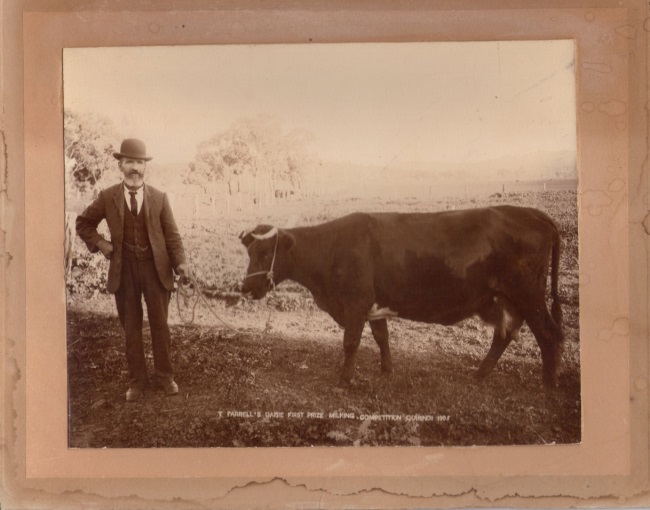
Little is known of Jim’s early life but, when he was only 14, his mother died at the age of 53 in June 1907 after a five-week illness. When he enlisted in the Army on 30 August 1915, Jim was described as being 5 feet 10½ inches in height and having “auburn” (reddish- brown) hair; his civilian occupation was a fettler (railway-line labourer).
James was described by 2169 Private George Senior, the soldier who had embarked for overseas with James, who "went over" behind him and witnessed his death, as a tall, red-haired man and a good fellow.
Enlistment
Jim enlisted at Narrabri as a private in the AIF and was posted to C Company, 31st Battalion within the 8th Brigade. The 31st Battalion was first raised at Enoggera, then on the outskirts of Brisbane, in August 1915. Some of the battalion’s companies, however, were also raised at Broadmeadows Camp in Victoria. In early October 1915, these two elements were united at Broadmeadows. Jim embarked from Melbourne on board HMAT A70 Ballarat on 18 February 1916.

The 8th Brigade joined the newly raised 5th Australian Division in Egypt, and proceeded to France in June 1916, destined for the Western Front. In May 2016, Jim was admitted for a week to the field ambulance at Ferry Post, Aden suffering from mumps. His movement to the Western Front was on HMAT A20 Hororata from Alexandria to Marseilles, disembarking on 23 June 2016, then by train to northern France.
France – The Battle of Fromelles
The Somme campaign began on 1 July 1916 with British attacks north of the Somme River. The “Fleurbaix” or "Fromelles" battle further to the north, designed as a "feint", was the first major action by Australians on the Western front and involved the 5th Division in an ill-planned daylight charge.
"The Australians had been force-marched to the start-line for the attack, planned for 17 July, but it was foggy and the attack was postponed…… The Germans began shelling the communications trenches where the Australians formed up, and the 8th Brigade suffered hundreds of casualties as they waited to advance, receiving fire, too, from the German lines further north, who had returned to the trenches when the British artillery had finished."
The 31st Battalion fought its first major battle in the fields between the towns of Fleurbaix and Fromelles on 19 July 1916, having only entered the front-line trenches three days previously. The attack was a disastrous introduction to battle for the 31st - it suffered 572 casualties, over half of its strength. One of them was Jim. He was probably killed in action in No-Man's Land, within about five minutes of "going over" at 6.00pm. But where he fell is subject to conjecture.
The battle was an unsuccessful Allied attack on the German defences on the outskirts of Fromelles. In a single night, 1,917 Australians lost their lives. Subsequently, the Australian Brigadier General Harold "Pompey" Elliott called the plan of the British General Officer Commanding 11th Corps, General Richard Haking, "a wretched hybrid scheme, which might well be termed a tactical abortion".
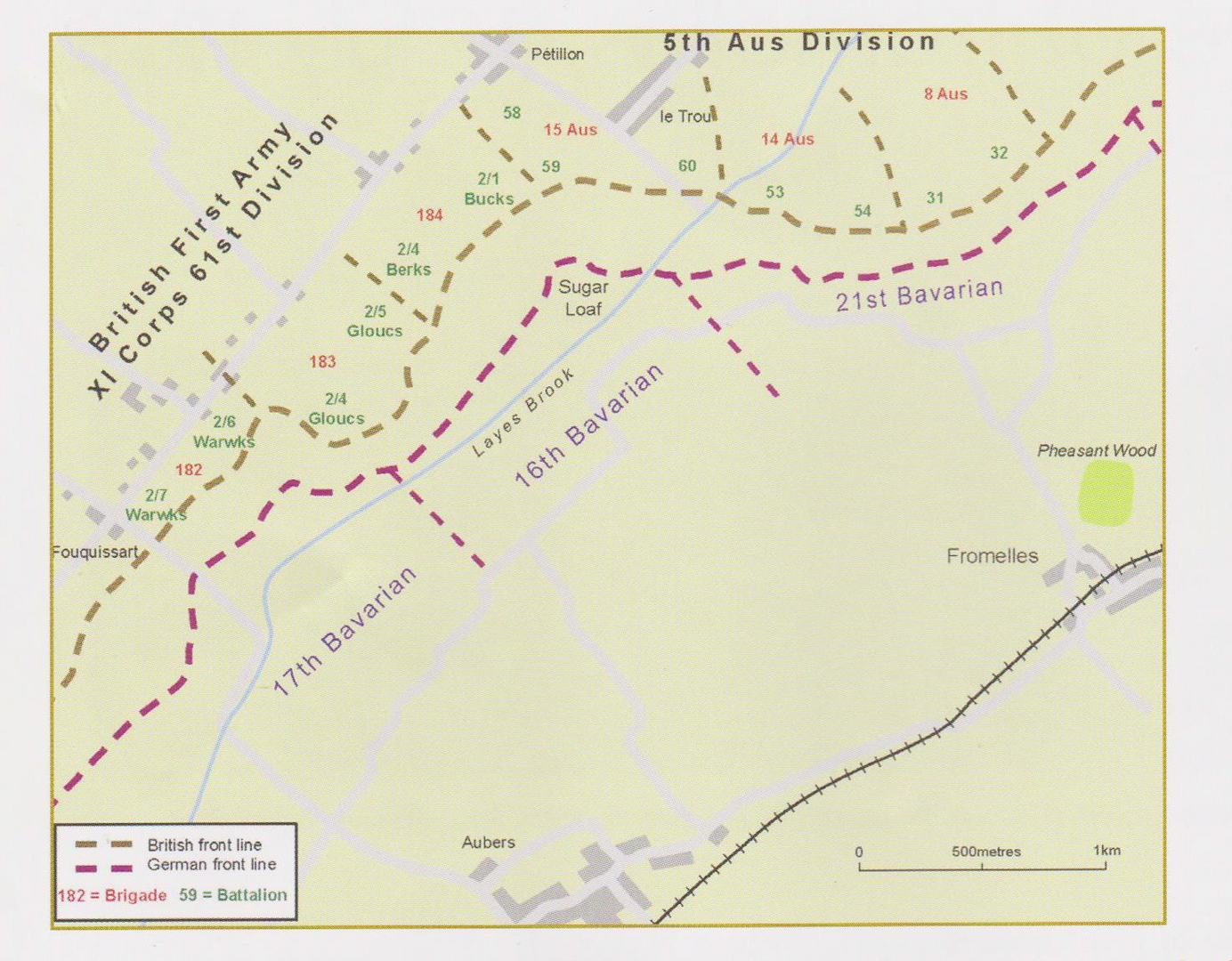
Patrick Lindsay AM in his 2007 publication Fromelles informs us that:
“The men of the 14th and 8th brigades fared better, managing to cross no-man’s land and overrun the German front-line and communication trenches just north of Fromelles. They separated into small units as they advanced into enemy territory, however, and as night fell the German counterattack now surrounded the Australians. At 3.30 a.m. they were ordered to return to their own trenches and for the next six hours they fought their way back across No-Man’s Land.”
Lt Col Frederick Toll led the 31st Battalion, breaking through the enemy front lines and taking his men far into German territory. He dug in and held on until ordered to withdraw. Toll survived Fromelles, winning the DSO for his leadership.
Seeking more on Jim’s fate
Officially, Jim has "no known grave" and, in an attempt to find out more about Jim’s fate, Kevin Farrell communicated by email with the Army History Unit and the Canberra office of the Commonwealth War Graves Commission (CWGC). The then Head of the Army History Unit, Dr Roger Lee, was most obliging and in an email dated 3 February 2016 said of 31st Battalion, “C Company, along with A Company, made up the first two waves of attackers and thus would have suffered casualties prior to and just as they left the cover of their breastworks.”
The Court of Inquiry, held in the field on 1 August 1917 (i.e. over a year after the battle) pronounced that Pte James S. Farrell was killed in action on 21 July 1916, which was the day he was reported missing.
In Robin Corfield's book Don't Forget Me, Cobber - The Battle Of Fromelles (2009), Pte James S. Farrell is included in the 31st Battalion’s Roll of Honour among the 40 soldiers "Noted as KIA 21 July" (page 457); he was one of the 23 soldiers with no grave and initially commemorated on the Villers-Bretonneux Memorial.
Evidence from the court of inquiry and Red Cross records supports Jim’s wounding / death occurring early in the battle on 19 July 1916, notably statements made by 2169 Pte George Senior, C Coy, 31st Battalion. George Senior had enlisted at Inverell aged 43 years and was in the 3rd Reinforcements, as Jim was. At the time of first giving his evidence in August 1916, George was a patient in Huddersfield War Hospital, England as he had been wounded at Fromelles. He stated:
“Informant states that at Fleurbaix about 1½ miles from Armentieres the following men were lying, to all appearances dead, outside the parapet of our trench.
2130 Pte. J. Farrel (sic) ………
1552, Pte. Tom McDonald …….
Informant saw the dead bodies, - the time was 6.30 p.m. The ground advanced over was held.”
In 1917 after being returned home to Australia and whilst a patient at the Randwick hospital, George gave a second statement:
“On the 19th July 1916 we 'went over'. Farrell was a little ahead of me in No-Man's land. I found him dead about 5 minutes after we went over at 6pm.”
There was no “Tom McDonald” as described in George’s first statement and service number 1552 was Ronald McDonald who was wounded in action but survived the battle, so there may have been a clerical error. It is possible that “Tom” may have been 2160, Charles McDonald. He was, like James and George, in the 3rd Reinforcements and was from Maitland - as was Pte George Senior. Charles McDonald, like James, was killed in the battle and has no known grave. Whoever the soldier was, it is a fair possibility that James was buried near him.
Dr Roger Lee [in his email to me of 3 February 2016] said:
“The CO of the Battalion wrote a report (you can read it in the Battalion's war diary) that states he had to send the third and fourth waves forward into the attack early, given the casualties in the first two waves. This would support your conclusion that he was killed early in the attack. This sort of helps our quest, as the likely cemetery in which he is buried was heavily influenced by where he was killed.”
In an email to Dr Farrell dated 31 August 2015, Lambis Englezos AM said there is “not enough information in his (Pte J.S. Farrell’s) file to indicate that he made it to or beyond the German line”.
Where might Jim be buried?
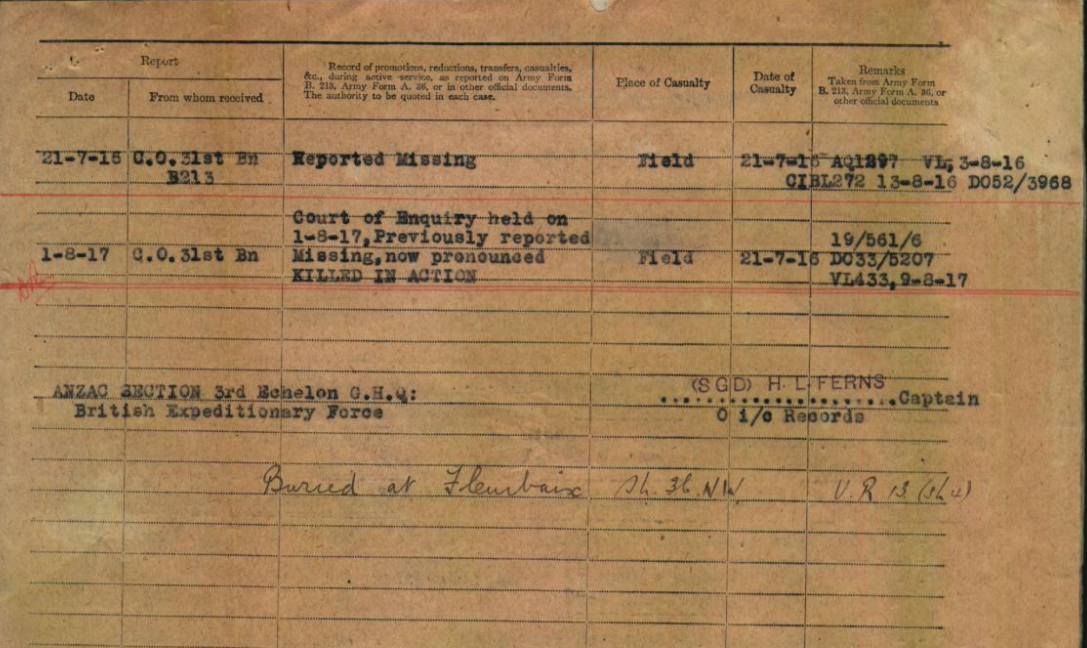
In Jim’s Army file on page 4 there is an undated, hand-written entry that he was "Buried at Fleurbaix" followed by an alpha-numeric grid reference, which can’t be read with absolute confidence. As pointed out by Maria Cameron, a scientist from Port Fairy, Victoria, another 31st Battalion soldier, 1553 Pte Archie McDonald (who has been recovered from the German burial pits, identified by DNA and is now buried at the Pheasant Wood Military Cemetery) has the same notation in his Army file.
An explanation of the notations was sought from the CWGC Enquiries Team but the response of 7 June 2016 was unhelpful. On 1 June 2016, Dr Lee responded at length on the file entries but in essence said “Given the 36NW reference, I am inclined to think the entry on his file is a simple mistake. The battlefield is nowhere near the areas covered by the NW map series”. Dr Lee said that if Jim was killed in or around the mid-point of No Man's Land, it is likely he was temporarily buried by the Germans in the partially completed communications trench the Australians were digging between their original front line and the German lines on the night itself.
There was a brief period where some 300 injured Australians in front of 8th Brigade lines were rescued after German and Australian officers had discussed an informal truce agreeing that each side's stretcher bearers would work in their half of no-man's land. The proposal to formalize this was refused by the General Officer Commanding 5th Australian Division, Major General James McCay - an Australian, born in Northern Ireland. As a result, not only did many of the wounded suffer unnecessarily agonising deaths, a great many of their mates were killed and wounded over the following days as they exposed themselves to continual fire in attempts to reach them.
Source Patrick Lindsay, Fromelles, 2007 - p 138
In this fashion, men were rescued from No-Man's Land for up to some 10 days after 19 July, but many bodies were left in No-Man's Land.
Over two years after the battle, on the day of the Armistice of 11 November 1918 when the guns of the Western Front finally ceased firing, Australian official war correspondent, Charles Bean, wandered over the battlefield of Fromelles and observed the grisly aftermath of the battle: “We found the old No-Man’s-Land simply full of our dead”, he recorded, “The skulls and bones and torn uniforms were lying about everywhere”.
Burials at Fromelles - VC Corner and Pheasant Wood
Soon after the war, these remains were gathered to construct VC Corner Cemetery, the only solely Australian war cemetery in France. As described on the Australian War Memorial website, this cemetery contains the remains of 410 unidentified Australians whose bodies were gathered up, mainly from No-Man’s Land, after the Armistice in 1918. Also buried there are the remains of Australians initially buried by the Germans in a common grave at Delangre Farm
Source Patrick Lindsay, Fromelles, 2007 - p 249.
It is most likely that these bodies were from the 32nd Battalion but could include some from the 31st. As none of the bodies could be identified, it was decided not to mark the individual graves, but to record on a memorial the names of all the Australian soldiers who were killed in the engagement and whose graves are not known.
We have since come to know that Allied soldiers killed in the area re-taken by the Germans, were buried shortly after the battle. The burial pits were photographed from a British reconnaissance aircraft on 21 July 1916 and marked as dugouts or trench-mortar positions. The bodies were taken by narrow gauge trench railway on 22 July 1916 and buried in eight 10 x 2.2 x 5 metre (32.8ft × 7.2ft × 16.4ft) pits
Source Wikipedia
The recovery in 2009 of allied soldiers buried in this fashion near Pheasant Wood and their re-burial in a new CWGC cemetery in Fromelles was the end result of submissions to the Australian Army and Department of Veterans Affairs over six or more years by military historian, Lambis Englezos AM, and others. Of the remains of those 250 Australian and British soldiers, more than 150 have since been identified, including more than 17 from the 31st Battalion. The means of identification included DNA matching with relatives of the dead soldiers.
The DNA search for Jim
Being unaware if any other descendants of Jim’s family had done so, Kevin Farrell participated in the Fromelles Project - Year 3 by providing a sample for DNA matching. He was notified on 20 April 2012 that Pte J.S. Farrell was not identified by the Joint Identification Board which met in London on 21 March 2012.
In a personal email, Maria Cameron, informed Kevin that a match may have been more likely with DNA from a female descendant of a sister of James, as mitochondrial DNA lasts so much longer in the skeletal remains. Her information has been passed on to appropriate relatives who Kevin has come to know in recent years so they may consider providing DNA.
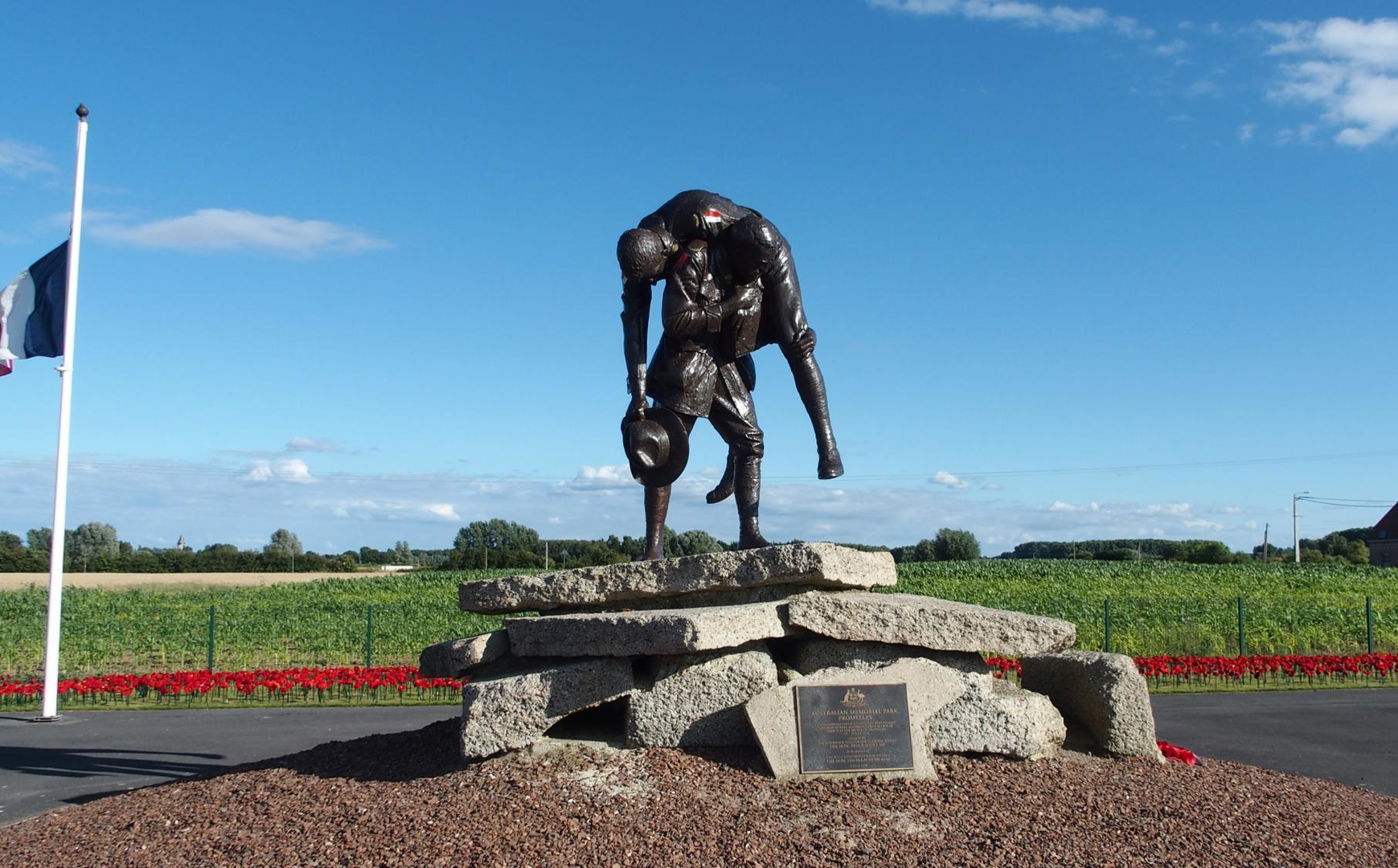
In conclusion, Dr Kevin Farrell believes that on 19 July 1916, early in the Battle of Fromelles, Pte James Stephen Farrell was killed in action in No-Man’s Land and the specific location of his remains is unknown. Most likely, he is interred in VC Corner Cemetery or nearby, in Rue Petillon. It is also possible that his body was destroyed by artillery fire or was buried in a trench or crater by the effect of artillery fire and his remains were never removed from the battlefield. It is less likely that he was buried by the Germans at Pheasant Wood.
Family left to mourn
News of Jim’s fate was slow to reach his family in New South Wales. Jim’s widowed father, Tom, received a telegram on 18 August 1916 informing him that Jim was reported missing in action on 21 July 1916. On 28 August, Tom wrote to the Army Records Office in Melbourne asking if his son was “wounded or dead or taken prisoner”. The Army’s response of 6 September did not expand on “missing”.
On 24 October 1916, Tom wrote to the Army saying that he had received no further information as to Jim’s fate but had received notice that Jim’s pay allotment would cease on 18 October 1916. The army’s reply of 30 October was to the effect that Jim’s fate was still unknown and that if Tom had been dependent on Jim, he should apply for a War Pension or an Old Age Pension! At some point, Tom received a war pension of 15 shillings per fortnight, backdated to 18 October 1916.
From the army files, it appears that Tom was officially notified on 17 August 1917 that his son Jim had been killed in action and his name was published on 27 August 1917 in newspaper lists of those killed. Subsequently, a Quirindi solicitor wrote to the Army Records Office in Melbourne requesting a death certificate for Jim to allow his estate to be finalized; it was provided on 30 November 1917. No doubt, it was a very sad time for Tom, losing a son overseas and not having the support of his wife.
As next of kin, Tom was the recipient of the pamphlet “Where the Australians Rest” and the Memorial Scroll (November 1921), as well as the Memorial Plaque, popularly known as the "Dead Man’s Penny" (September 1922). Pte J.S. Farrell was awarded the British War Medal the 1914-15 Star, and the Victory Medal, these being sent to his father, Tom after the War.
Jim is commemorated on the Roll of Honour at the Australian War Memorial (panel number 118) and, until recently, at the Australian National Memorial, Villers-Bretonneux, France. The latter commemoration has been transferred, or is in the process of transfer, to the VC Corner Australian Cemetery and Memorial. He is also commemorated on:
- Castlemountain First World War Roll of Honour, now located at the Quirindi Cottage and Museum; and
- The NSW Government Railways and Tramways, First World War Roll of Honour, Central Station, Sydney
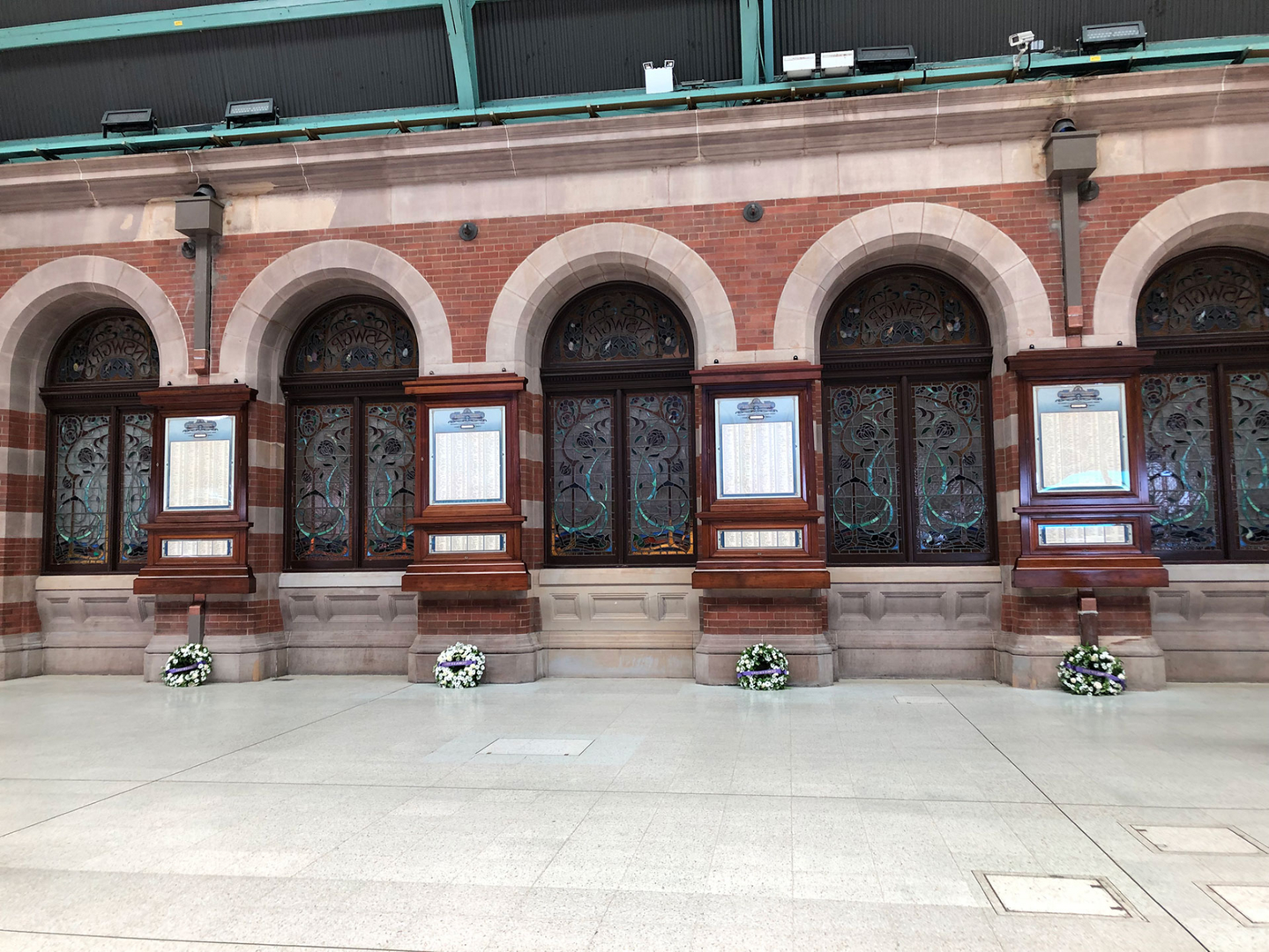
Remembered by later generations
Dr Kevin Farrell and his wife were privileged to attend the service at Pheasant Wood Military Cemetery, Fromelles on the occasion of the centenary of the battle on 19 July 2016. There they met, for the first time, Brett Farrell who is also a first cousin twice removed of Jim.
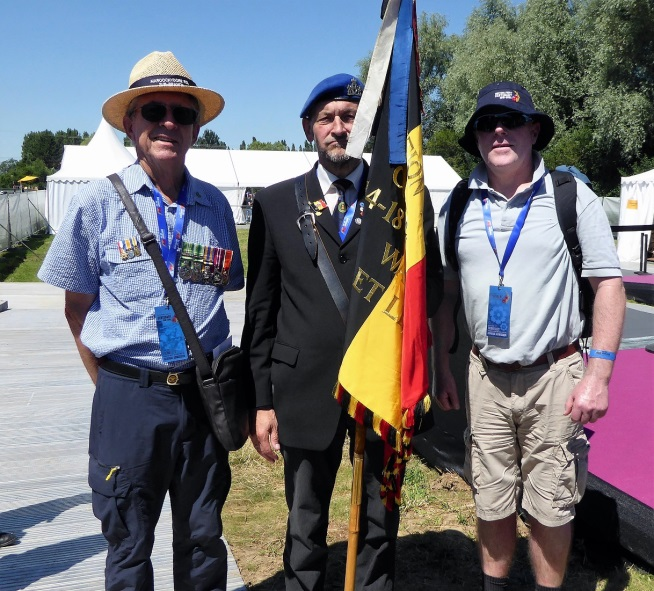
In addition, Peter Campbell, a grandson of Jim’s oldest sister Catherine, produced a CD, “Better Late Than Never” which includes a song in tribute to Jimmy titled “The Lost Soldier”. The song was written by Peter with assistance from Brendan Walmsley and it won the 2020 Tamworth Songwriter's Awards, Anzac Song of the Year. It is dedicated to all those who served and can be accessed below or via YouTube by clicking the link: https://www.youtube.com/watch?v=H2tl_T4Vhzo.
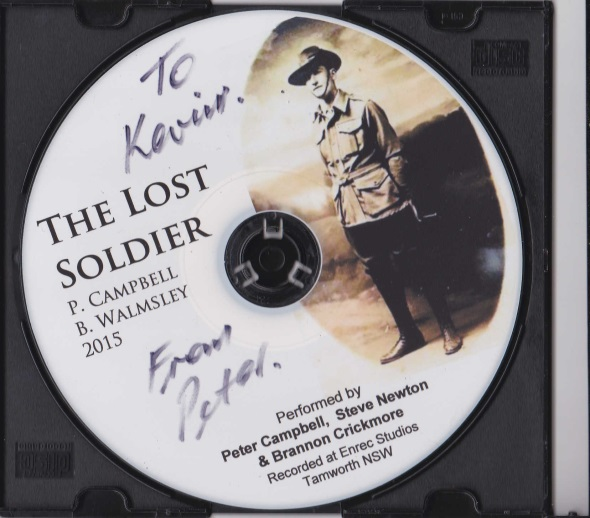
As time passes, family members, including Peter Campbell and Brett Farrell, continue to provide DNA samples to see if a match can be found with any of the so-far unidentified bodies recovered at Pheasant Wood, Fromelles.
Jimmy has certainly not been forgotten!
“....if only the generals had not been content to fight machine gun bullets with the breasts of gallant men, and think that that was waging war.”
Mt DNA is still being sought for family connections to
| Soldier | James Stephen FARRELL 1892-1916, Castel Mountain, Quirindi, NSW |
| Parents | Thomas James FARRELL 1854-1929 – New South Wales and Honora SCANLON 1851-1907 – New South Wales |
| Grandparents | |||
| Maternal | Patrick SCANLON b. 1816 d.1881, NSW and Catherine SCANLON b. 1826 d, 1902 , NSW |
Seeking DNA Donors

Contacts
(Contact: carla@fromelles.info or geoffrey@fromelles.info).
(Contact: army.uwc@defence.gov.au or phone 1800 019 090).
Donations
If you are able, please contribute to the upkeep of this resource.
(Contact: bill@fromelles.info ).
